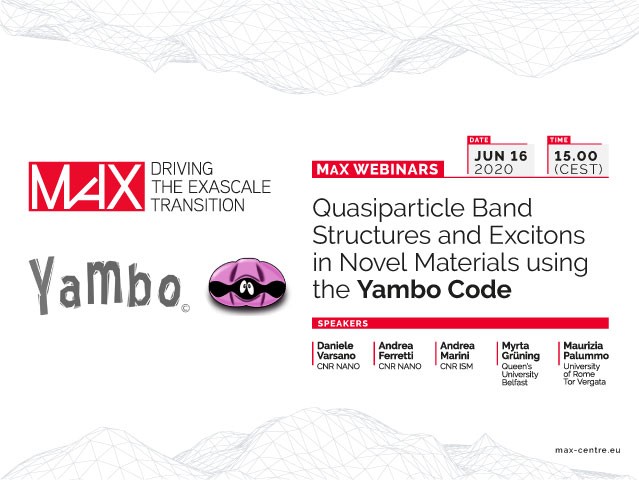Quasiparticle Band Structures and Excitons in Novel Materials using the Yambo Code

Yambo(opens in new window) is an open-source project aimed at studying excited state properties of condensed matter systems from first principles using many-body methods. As input, Yambo requires ground state electronic structure data as computed by density functional theory codes such as Quantum ESPRESSO and Abinit. Yambo’s capabilities include the calculation of linear response quantities, quasi-particle corrections based on the GW formalism, optical absorption, and other spectroscopic quantities. Recent developments range from the electron-phonon interaction and a real-time approach to linear and non-linear optical properties.
New HPC clusters based on accelerators will soon enter the production phase. These machines are conceptually different from most of those previously employed by Yambo users. Indeed, Yambo HPC users are typically accustomed to machines based on massive MPI parallelism and often need to acquire more familiarity with heterogeneous machines based on GPUs.
The MaX European Centre of Excellence(opens in new window) is working to prepare Yambo for the forthcoming pre- and exascale machine. The scope of this webinar is, indeed, to provide a broad view of the Yambo code, where to get it from and how to use it. We will also provide an update of the status of the GPU version and outline the roadmap for its future evolution. We will also provide a basic set of instructions on how to tune and use the code efficiently on these new HPC systems.
Following a general introduction on a linear response, quasiparticles and excitonic effects the webinar will focus on how to obtain optimal performance on these new systems. An introductory talk will provide basic instructions on how to manage the resources on GPU-based machines, followed by a tutorial explaining how to compile and tune up the code.
Register now!(opens in new window)
Who should attend
Users of electronic structure codes interested in the calculation of excited-state properties, particularly those who plan to start working on modern heterogeneous (accelerated) HPC machines. In particular, after a guided tour of the features of Yambo, the last part of the webinar will provide more specific information for users willing to run on GPU-accelerated machines.
Key Takeaways
- Status and features of Yambo running on GPU based systems
- How to use optimally Yambo on heterogeneous HPC systems
- How to compile and tune-up Yambo for GPUs, which tools and libraries are needed.
Visit the official webinar page(opens in new window) to register and see the exciting agenda prepared for its attendees.
---
About MaX
MaX - Materials design at the Exascale has received funding from the European Union’s Horizon 2020 under Grant Agreement n. 824143. Led by CNR (Italy), the MaX consortium partners includes SISSA (Italy), ICN2 (Spain), JUELICH (Germany), CEA (France), EPFL (Switzerland), Universiteit Gent (Belgium), CINECA (Italy), BSC (Spain), ETHZurich (Switzerland), E4 (Italy), ARM (United Kingdom), ICTP (Italy), Trust-IT (Italy).
www.max-centre.eu I www.linkedin.com/company/max-centre I @max_center2(opens in new window)


